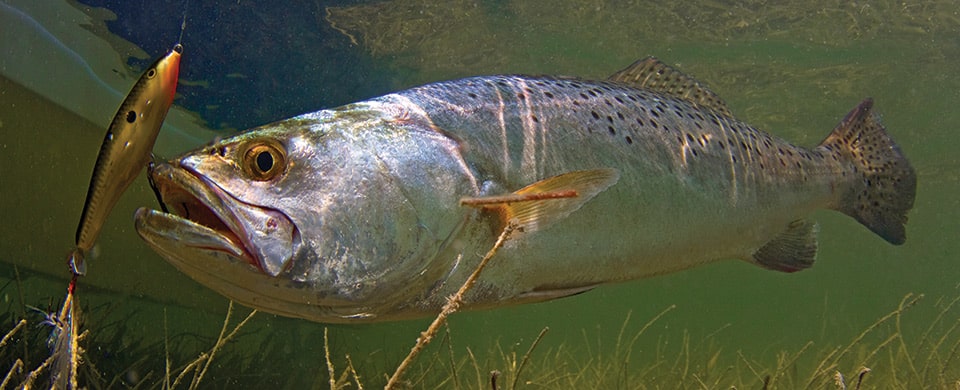
Mississippi Trout Fishing
Anglers know that Louisiana waters teem with willing redfish and abundant trout, but what about the Bayou State’s next-door neighbor – Mississippi?
Mississippi holds a local secret only a handful of traveling fishermen have realized: The state offers a prime jumping-off spot for plying the fish-rich Biloxi Marsh (which is in Louisiana waters) that’s only 20 to 40 minutes away from Gulfport or Biloxi casinos, water parks and beaches.
“Where we are on the Gulf Coast – Bay St. Louis – is the closest point from Mississippi to get to the Louisiana marshes,” says Capt. Sonny Schindler, managing guide for Shore Thing Charters. “The area of the Biloxi Marsh we fish we kind of have to ourselves.”
The editors of Sport Fishing shared that secret with Schindler and fellow guide Matt Tusa during the summer of 2008. We literally wore out the trout under flocks of birds and released multiple reds along the miles and miles of grass and oyster-reef shoreline.
Summer makes for a slightly more difficult time to fish than fall because daytime air temperatures spike to 100-plus and the shallow water practically steams. Schindler leaves port at first light and returns by midday. As fall descends and water temperatures cool toward 72, he can fish longer hours.
Trout by Twos
Our first run to the marsh in two boats – a 23-foot Parker and a 21-foot Kenner – proved comfortable and fairly short. When light winds prevail, the guides make the 12-mile run south across the sound in about half an hour. Three miles off the Mississippi coast, they enter Louisiana waters.
The Biloxi Marsh marks the eastern edge of Louisiana’s Lake Borgne. Louisiana anglers to the west find much closer locations to fish, which leaves this eastern marsh complex open to Schindler and the handful of other coastal Mississippi guides.
They target trout first, searching for flocks of diving birds over water six feet deep or less. June through September mark the best months for frenzied trout action. The drill is simple: “The bigger fish seem to stack up in shallower water,” Schindler says. “Shrimp come through in massive numbers. The size of the shrimp dictates the size of the trout. When you see 6-inch (16- to 20-count) shrimp, the trout will go 2 pounds or better.
“We use the trolling motor to get upwind of the birds and drift the outside of the school beneath them. We go through, get two at a time each, and then repeat.”
Schindler uses tandem rigs armed with 3/8-ounce jig heads and plastic Cocahoe Minnows in electric chicken, opening night or avocado colors. No need to use live shrimp or even shrimp imitations: “You could throw your keys in there and they’d eat ’em,” Schindler jokes.
And he’s right. As our group of three anglers drifted past the school, we scored double hookups even as we elbowed each other for room at the bow. But we quit harvesting as soon as we had enough trout to feed our group for the night. Even with the fairly liberal Mississippi daily bag limit of 15 trout of at least 13 inches per person, we saw no need to fill the cooler.
When Size Matters
When anglers want to target bigger trout in the 3- to 6-pound range, Schindler takes them to the natural-gas rigs in eight to 15 feet of water just outside the marsh. The rigs are anchored beneath a shell pad that becomes a mecca for big trout. Tarpon and pompano also visit the rigs in summer.
Schindler baits a Carolina rig with a live cocahoe minnow, croaker or shrimp and tosses the weighted offering to the platform. “You may not get the numbers you’d get under the birds,” he says. “But they’ll make it up in size.”
Redfish averaging 16 to 27 inches flourish in the marsh; lucky anglers may even sight-cast to fish patrolling the edges of the grass. “We look for a gradually sloping bank with some sort of oyster or grass bottom,” Schindler says. “Or any abnormality in the marsh – a 5-foot break or a foot-long point. They congregate anywhere like that.
“You can be trolling a bank and not see fish; then you come into a bay the size of a pickup-truck bed and 10 or more of them are horsin’ around in there. The greater the number, the more aggressively they feed.”
Bull reds seek open water around schools of white trout or mullet. Live shrimp under popping corks work well, as do spinnerbaits and weedless spoons over grass. Topwaters such as MirrOlure Top Dogs or She Dogs, Rapala Skitter Walks and various Sebile lures readily take reds when cast by skilled anglers.
One Rig Fits All
Schindler uses 7-foot, medium-light Shimano Trevala rods with a medium-fast action, paired with Sedona or Sahara reels spooled with 30-pound PowerPro. “That may seem like overkill,” he says. “But it’s mainly because of the transition during the day to targeting redfish. We can’t bring too many rods.”
To the braid, Schindler attaches a short length of 12- to 17-pound fluorocarbon leader and either a 3/8- to 1/2-ounce jighead or a 1/0 Kahle live-shrimp hook.
Once the day heats up, Schindler picks his way home, stopping at the pilings, channel markers and crab-trap floats along the way. He’s searching for tripletail, a fairly common find from May through September. Most of these odd-looking, usually structure-oriented fish caught in Mississippi won’t grow large enough to set any world records, but as Schindler says, “It’s a great way to end the day.”









